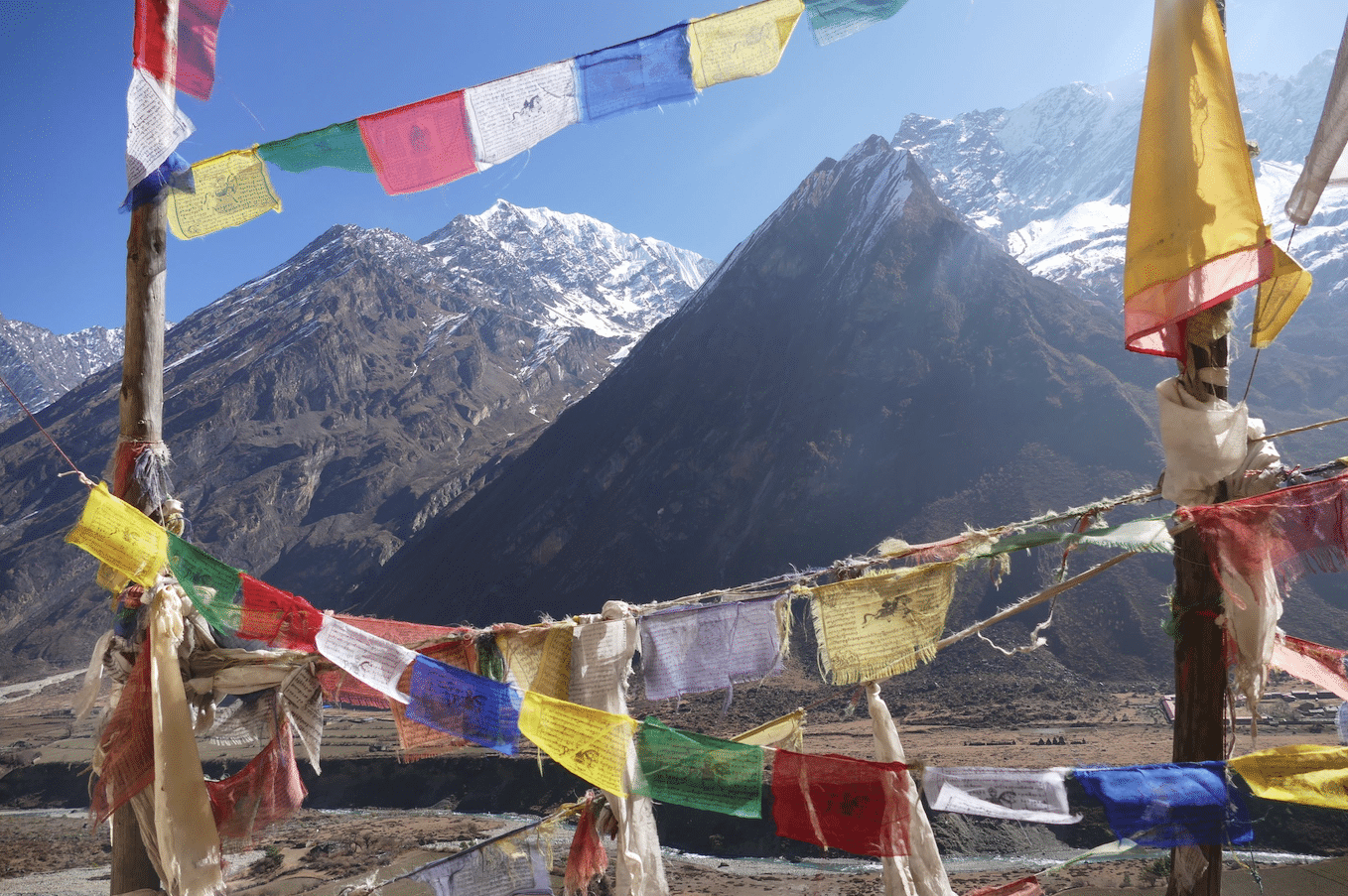
by World Moms Blog | Mar 17, 2015 | 2015, Awareness, Humanitarian, Inspirational, World Moms Blog, World Voice
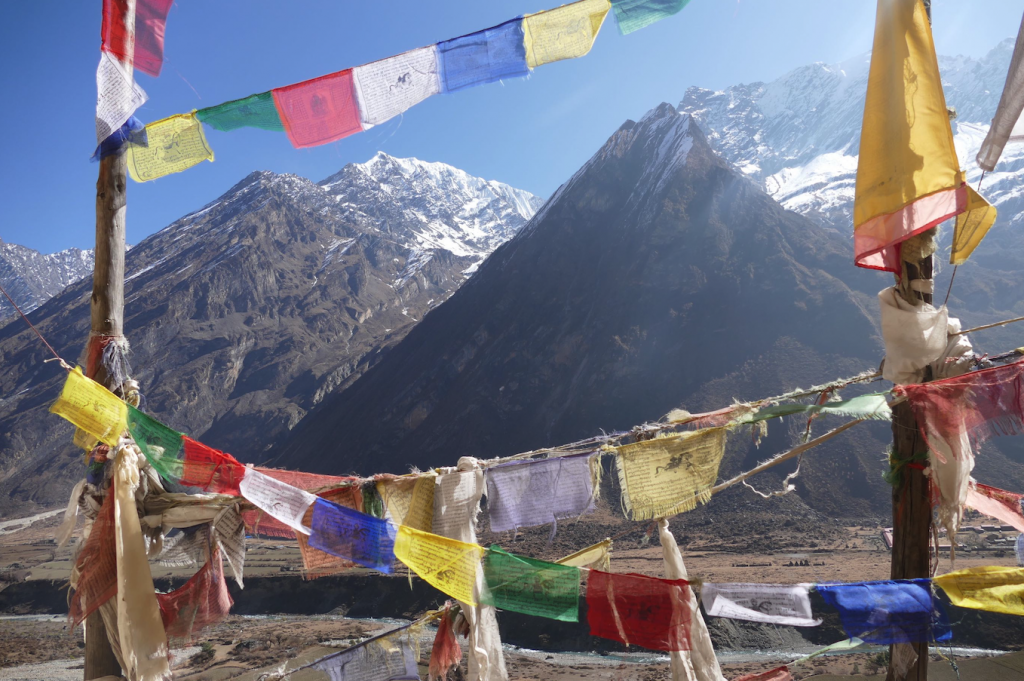
Today our team has returned to the warm embrace of our families in Singapore, but undoubtedly, a piece of our heart was left behind in the sacred Tsum Valley of Nepal, captivated by the thousand smiles we came across during this beautiful and arduous journey. Indeed, Tsum, also known as a beyul or sacred land, had a profound influence on us.
This magical and untouched region of Nepal, one of the most secluded of Himalayan valleys, which only became accessible to tourists in 2008, affected us in ways we don’t yet fully comprehend.
The valley, once part of Tibet, looks completely different in terms of people and culture, from other parts of Nepal. The people of Tsum are Tibetan in origin with their own ancient dialect, art, culture and religion. In addition to the spiritual richness of this expedition, our itinerary was challenging and at times, even a little perilous. It required us to push our physical and mental limits, conquering fears, and dealing with extreme cold and exhaustion, while climbing to increasingly higher altitudes. We gained a total of 4,400 metres of altitude over a distance of 150 kilometres in less than seven days.
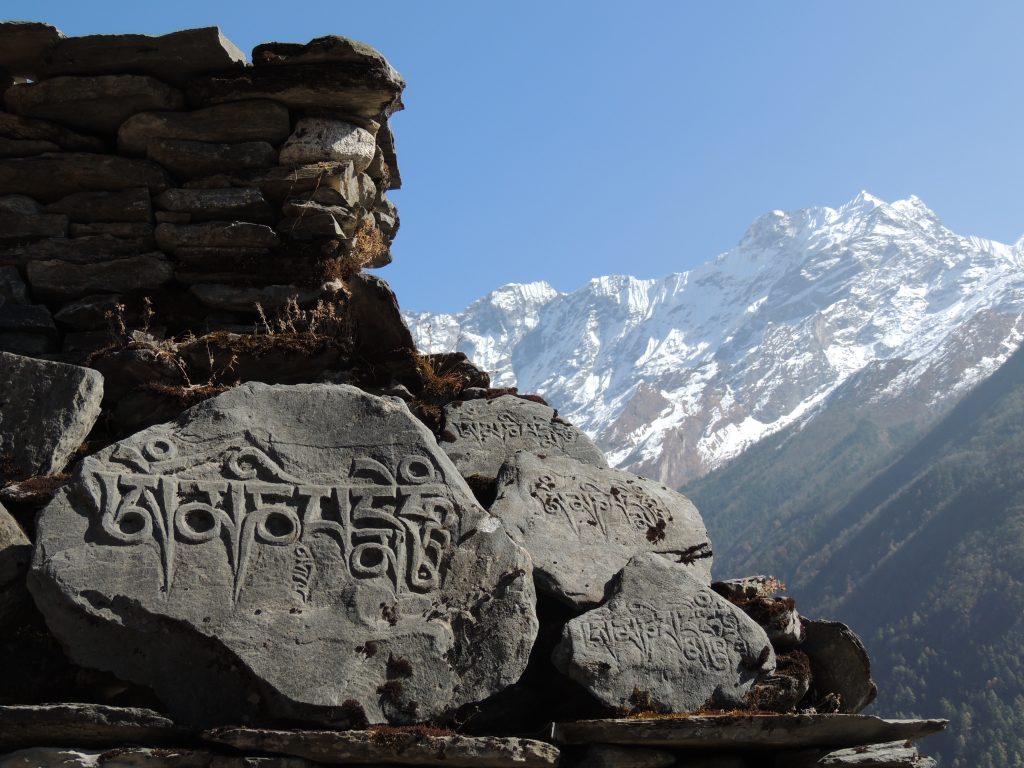
We started in Soti Khola, in the lowlands, visiting sacred caves and secluded villages. As we continued to climb higher, we saw the vegetation and landscape change before our eyes, from thick tropical foliage to lush pine forests. We continued our journey on steep mountainous trails, passing brightly coloured prayer wheels and numerous stupas – little Buddhist shrines. As we gained altitude, the temperatures plummeted, while the landscaped turned moon-like, with a thick blanket of powdery snow covering the peaks surrounding us.
Every day on our journey upwards, we came across caravans of mules and Yaks laden with supplies on their way to and fro Tibet. The people in this region of Nepal have been trading with their Tibetan neighbours for centuries and continue to do so despite the political vagaries affecting Tibet’s status as a nation in relation to the People’s Republic of China.
After an intense week of trekking we reached Mu Gompa (3,700m), where we began a three-day retreat in a century-old monastery. There, we set aside quiet moments in our day for meditation and reflection, as we rested and prepared for our challenging day climb to the Ngula Dhojhyang Pass, perched on the Nepalese-Tibetan border at 5,093m of altitude.
Finally the time came for us to scale the Ngula Dhojhyang Pass. However, because Mu Gompa Monastery is the last place available for trekkers to stay at, past this altitude, if we were to return before dusk, we had to leave no later than 4:30am. An intense 13 to 14-hour climb lay ahead of us.
Luckily the weather had been glorious over the past few days. We were conscious that just a few weeks back, not far from this region, in the Annapurna mountain range, a freak blizzard had just occurred. This unexpected storm arriving in late October, at the peak of the trekking season, had caused the deadliest mountaineering disaster in Nepal’s history. At least 43 people were killed when the blizzard caught them off guard on the trails.
A few other obstacles lay ahead of us on this high pass attempt. For the team to reach that section of the Tibetan border, we had to cross six landslides in total darkness and once again on the way back, ideally while there was still some daylight left.
Nevertheless, our determined team left Mu Gompa Monastery with head torches on at 4:30am in below freezing temperatures. The cold was so intense that the water in our camelbaks remained frozen until 9am. We continued climbing, crossing vast windy plains, traversing numerous icy rivers, scrambling over slippery rocks and small glaciers, and scaling a total of 1,400 metres in one go. Finally at noon, exhausted and cold, but euphoric beyond words, we made it to the Nepalese/Tibetan border at the highest point on the ancient trade route. 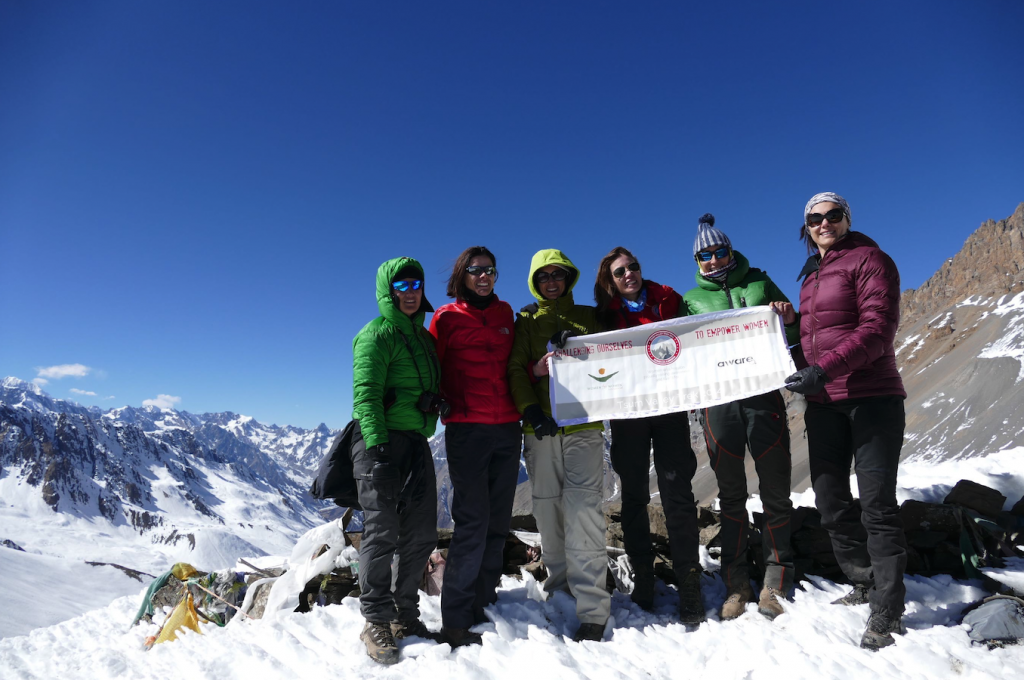
At the top we unfurled a banner reaffirming our commitment to challenge ourselves and empower women around the world.
We stayed 20 minutes on the windy summit, drinking in the stunning views on both sides, and headed straight back down to Mu Gompa, racing to return before dark. Finally 13 hours after our departure, as daylight began to fade, we walked into the monastery’s dining hall completely shattered and drained, but standing tall despite the overwhelming fatigue, with a deep sense of achievement and pride in our hearts.
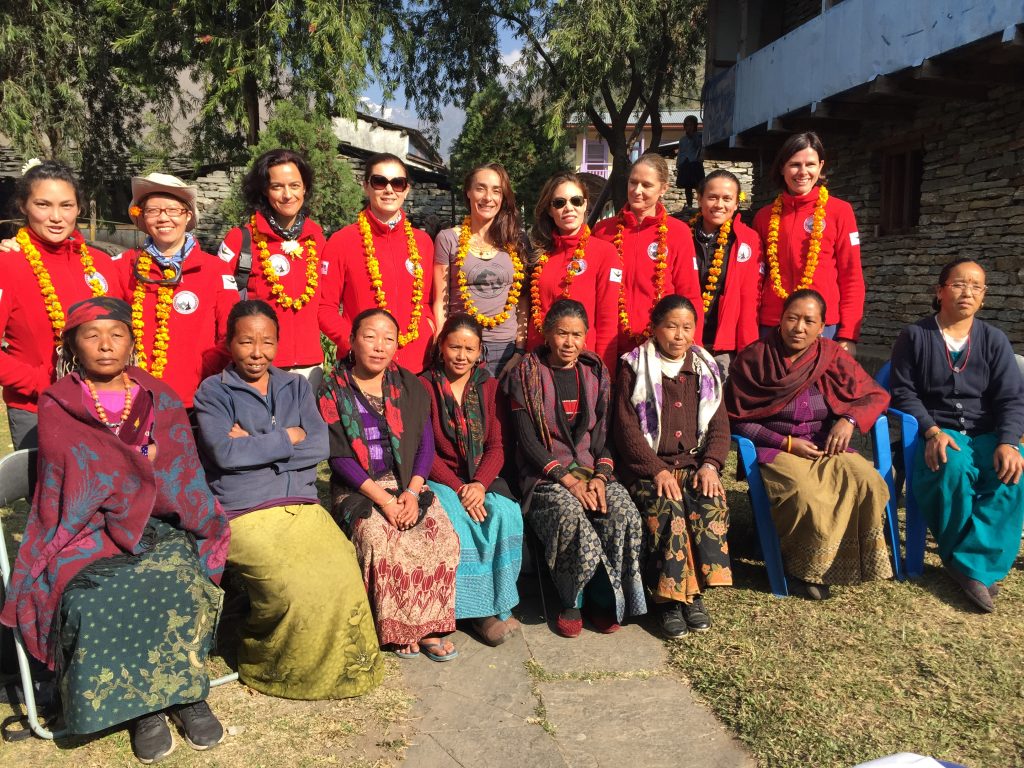
As you can imagine on such a journey, there was much laughter and often tears, of both triumph and frustration, but what we discovered at the end of it all was something far more rewarding. We came to know a people who cherish the simplicity of their lives over any material comfort or possessions. On numerous occasions along the trail, the people of Tsum welcomed us, perfect strangers, into their homes. Their hospitality, kindness and wisdom touched our hearts forever.
Ultimately, we embarked on this journey to support other mothers, daughters, and sisters whose lives have been ripped apart by the horrors of war, women who have been humiliated and raped, robbed of their dignity, whose self-esteem and freedom have been taken away from them. Even if we could never claim to truly understand the suffering they went through, doing something out of the ordinary and dedicating it to these brave women made us feel like we were standing in solidarity with them, and it gave us wings as we climbed higher.
Despite the constant longing for clean toilets, hot running water, warm beds and comfort foods—not the mention the rats we encountered running across our sleeping bags, in the middle of the night in one of the lodges —all the little “hardships” we endured were long forgotten once we were safely back home in Singapore.
It was truly an unforgettable journey in the land of the clouds. From the many multi-coloured prayer flags fluttering in the wind high above our paths, to the beautiful khata – silk scarves – we received as parting gifts, undoubtedly, the beauty of the Tsum Valley will remain alive, etched in our memories forever. No wonder many believe the Himalayas retain a small part of your soul, forever captured and resting peacefully awaiting your return.
Christine Amour-Levar is the Founding Partner of Women on a Mission (WOAM), a non-profit organization that combines challenging, self-funded, expeditions to remote and majestic locations around the world, with inspirational fundraising events, as a means to raise awareness and funds for women victims of violence.
For more information, please visit www.womenmission.com
Or on Facebook: www.facebook.com/WOAMSingapore
This is an original guest post written for World Moms Blog by Christine Amour-Levar.
All photos provided for this post by by Christine Amour-Levar.
Have you ever challenged yourself in such a way as a tribute to others suffering? We’d love to hear your stories!
World Moms Blog is an award winning website which writes from over 30 countries on the topics of motherhood, culture, human rights and social good. Over 70 international contributors share their stories from around the globe, bonded by the common thread of motherhood and wanting a better world for their children.
World Moms Blog was listed by Forbes Woman as one of the "Best 100 Websites for Women 2012 & 2013" and also called a "must read" by the NY Times Motherlode in 2013. Our Senior Editor in India, Purnima Ramakrishnan, was awarded the BlogHer International Activist Award in 2013.
More Posts

by Tara Bergman (USA) | Mar 13, 2015 | 2015, Awareness, Communication, Life Lesson, Tara B., USA, World Motherhood, Writing

I currently have someone in my life with whom I can only contact via letters. I am talking about snail mail, meaning hand writing or typing a cohesive self-narrative, putting a stamp on it, and sending it out into the world via the U.S. Postal Service. While this may not sound earth shattering, I’ve experienced a cognitive re-awakening. Living so fully immersed in the world of social media, texting, and email, I forgot what it was like to truly engage in traditional correspondence. (more…)
Tara is a native Pennsylvanian who moved to the Seattle area in 1998 (sight unseen) with her husband to start their grand life adventure together. Despite the difficult fact that their family is a plane ride away, the couple fell in love with the Pacific Northwest and have put down roots. They have 2 super charged little boys and recently moved out of the Seattle suburbs further east into the country, trading in a Starbucks on every corner for coyotes in the backyard. Tara loves the outdoors (hiking, biking, camping). And, when her family isn't out in nature, they are hunkered down at home with friends, sharing a meal, playing games, and generally having fun. She loves being a stay-at-home mom and sharing her experiences on World Moms Network!
More Posts

by Shaula Bellour (Indonesia) | Mar 12, 2015 | 2015, Awareness, Being Thankful, Exercise, Expat Life, Family, Health, Hobby, Identity, Indonesia, Inspirational, Life, Life Balance, Life Lesson, Living Abroad, Maternal Health, Me-Time, Motherhood, New Year's Resolutions, Parenting, Responsibility, Running, School, Shaula Bellour, Womanhood, World Motherhood
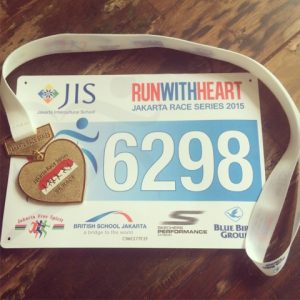 Last Sunday I ran my first 5K race. I still can’t believe that I actually did it – and in the tropical heat, no less. Although I have vaguely considered it a worthy goal, running an actual race wasn’t on my radar even two months ago.
Last Sunday I ran my first 5K race. I still can’t believe that I actually did it – and in the tropical heat, no less. Although I have vaguely considered it a worthy goal, running an actual race wasn’t on my radar even two months ago.
It turns out that 2015 is the year of living dangerously…out of my comfort zone.
My kids often talk about being “risk-takers”. It is one of the ten traits included in the school Learner Profile and students are encouraged to be inquirers, knowledgeable, thinkers, communicators, principled, open-minded, caring, risk-takers, balanced, and reflective. While these traits are all deemed equally important, being a risk-taker is a concept that seems to be especially resonant outside of school too: “I am a risk-taker: I am willing to make mistakes. I am confident and have the courage to try new things.”
For my generally confident (and fruit-averse) daughter, this might mean: “Look Mommy, I’m a risk-taker, I’m eating a mango!” My son takes a more reflective approach – acknowledging when he feels nervous about doing something and emboldening himself with his risk-taker status to eventually take the plunge. Though risk-taking will probably have a different connotation when they are older, I embrace what it means for them now – trying new things and not being afraid to make mistakes.
It’s an important lesson for grown ups, too.
In January, after three years of living in Jakarta, I was starting to feel like my daily life was becoming somewhat routine. Gym, work, grocery store, repeat. To change things up, I found myself saying YES to things that I might not usually consider.
When a friend asked if I wanted to join their early morning running group, I said YES. I knew that the group would likely be too advanced for me but figured that I wouldn’t know if I didn’t try. “What’s the worst that could happen?” I asked myself. I would walk, that’s it. I did walk some at first, but I set my own goals and improved each week. Now we’re training for a 10K.
When another friend asked if I would like to be part of their dance group for an upcoming fashion show event, I said yes to that too. Other friends and even my husband were surprised. Performing a dance routine in front of a huge crowd is WAY beyond my comfort zone, but again I thought: “Why not?” In this case I try not to think about the worst that could happen (falling off the stage comes to mind) but I’m proud of myself for doing it and am actually looking forward to the big night.
I’ve continued with the YES theme in other areas of my life and have already seen positive changes: improved health, new friendships, new possibilities. I’ve realized that pushing my boundaries in this way is also about adjusting my own perceptions of myself. “Oh, but I’m not a runner,” I would repeatedly explain, trying to somehow qualify my actions.
Well now I am a runner. And a dancer. Among many other things.
Life begins at the end of your comfort zone.
Our kids may not recognize some of the bigger risk-taking decisions we’ve made (like moving our lives halfway around the world), but it’s often the smaller actions that resonate the most.
It feels good for them to see that I can be a risk-taker too – I can be afraid sometimes and I can also be brave, just like they are.
When I walked in the door after the race, finisher’s medal around my neck, both kids jumped up from the couch with wide eyes. “Mommy!” my daughter exclaimed, “I didn’t know you would win the race!”
Not exactly…but YES! In my own way, I did.
What risks are you putting out there for yourself this year? How are you embracing these challenges?
This is an original post for World Moms Blog by our mom of twins in Jakarta, Indonesia, Shaula Bellour.
The image used in this post is attributed to the author.
Shaula Bellour grew up in Redmond, Washington. She now lives in Jakarta, Indonesia with her British husband and 9-year old boy/girl twins. She has degrees in International Relations and Gender and Development and works as a consultant for the UN and non-governmental organizations.
Shaula has lived and worked in the US, France, England, Kenya, Eritrea, Kosovo, Lebanon and Timor-Leste. She began writing for World Moms Network in 2010. She plans to eventually find her way back to the Pacific Northwest one day, but until then she’s enjoying living in the big wide world with her family.
More Posts

by Susie Newday (Israel) | Mar 11, 2015 | 2015, Israel, Life Balance, Parenting, Susie Newday, Working Mother, World Moms Blog, World Motherhood, Younger Children
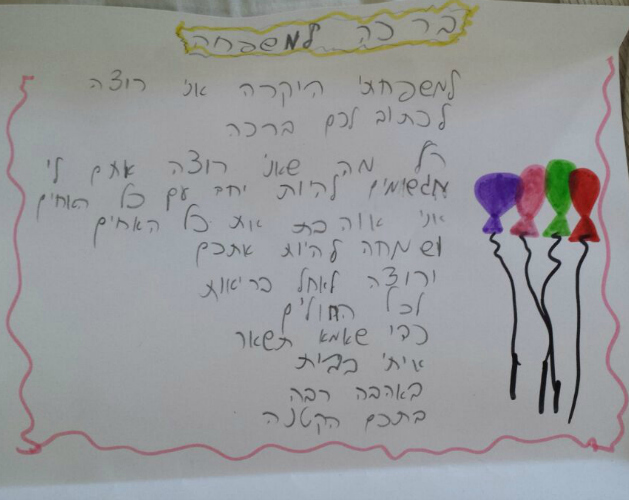
I was blindsided.
It was Family Day, or Yom Hamishpacha, as it’s called in Hebrew. The day that somehow ended up replacing Mother’s Day here in Israel. My youngest was so proud of the card she had made for my husband and me. She had colored pictures of balloons, and had written all the words on her own.
I smiled as I read lines of “To my dear family, all the things I want you fulfill,” and, “I love my siblings and I’m happy to be with you.”
The sucker punch came at the end.
“I want to wish for health for all the sick people in the world so that my mom can stay home with me.”
Ouch. A heartfelt painful dagger to the heart. I was caught off guard. She had never said anything to me about not wanting me to work.
I work part-time, only three days a week. I’m a nurse in outpatient oncology. I do important work, fulfilling work. I work because my salary makes a difference in our finances. I work because if I don’t work, it’s that much harder to get back into it when you do want to work.
And yes, there are days when I wish I didn’t have to work. There are also many days when I’m glad I do work. Yet like every working mother, I’m constantly tormented by the demands of both worlds and with the impossibility of finding balance. I think the emotional and mental balance is even harder to find than the physical, task-related balance.
And then, when I think I’ve found that precarious balance, I get hit by innocent words, words pleading for more love and attention than I’ve been giving.
All I can do is accept what is, and try harder. Try harder to be true to my needs and to give those I love what they need.
The question is how.
Any tips?
This is a post original to World Moms Blog. Photo credit to the author.
Susie Newday is a happily-married American-born Israeli mother of five. She is an oncology nurse, blogger and avid amateur photographer.
Most importantly, Susie is a happily married mother of five amazing kids from age 8-24 and soon to be a mother in law. (Which also makes her a chef, maid, tutor, chauffeur, launderer...) Susie's blog, New Day, New Lesson, is her attempt to help others and herself view the lessons life hands all of us in a positive light. She will also be the first to admit that blogging is great free therapy as well. Susie's hope for the world? Increasing kindness, tolerance and love.
You can also follow her Facebook page New Day, New Lesson where she posts her unique photos with quotes as well as gift ideas.
More Posts - Website
Follow Me:






by shootiegirl | Mar 10, 2015 | 2015, Social Good, Womanhood, Women's Rights, World Moms Blog, World Voice

Photos by Elizabeth Atalay
This past Sunday the world celebrated International Women’s Day.
What does it mean to be a woman? For me, it means the sky is the limit. I can be a wife, a mother, a corporate woman, an entrepreneur, a philanthropist and an artist. Yes! All at the same time! Because I was raised by a woman of such strength and power, I’ve never set any limits for myself. Frankly, I didn’t even know they existed. I have always felt propelled, even at a very young age, to DREAM BIG and move beyond the status quo.
As a mother of two girls, I live my life in a way that proves to my daughters that a glass ceiling is non-existent. Who says they can’t become engineers and architects because they are female? What about an astronaut, fire fighter, dancer, fashion designer?
I often remind them that wherever their minds can take them, they can reach any of those goals and beyond. Why? Because there are no boundaries, unless they create them.
Women around the world measure happiness and success differently. Whether it’s bringing your children to school safely in a dangerous area, raising your child to dream of and follow the profession of their choice, standing up so your daughter is not married off in childhood, giving your children the support they need to do well in school, or providing food for your family by working hard at a job just to make ends meet, these are all great efforts we are making to pave the way for a better world. We all share the desire for happiness and success for our children worldwide.
I encourage you to celebrate the women around and beyond you! In order to stay empowered, we must reach out to lift another woman up. Help her to find her happiness and success!What is your idea of happiness and success?
This is an original post written by Shootiegirl creator LaShaun Martin for World Moms Blog.
What is your idea of happiness and success?

LaShaun Martin is National Director of Social Media and Community Service for Mocha Moms, Inc. a national 501(c)(3) support group for stay-at-home mothers of color. LaShaun currently works to manage and promote community service programs for the organization to include teen mentoring, Boys Booked on Barbershops literacy program, America’s Promise, MomsRising, Moms Clean Air Force, U.S. Environmental Protection Agency, and U.S. Department of Education. She is a frequent guest of the White House for events focused on women and girls including tea with First Lady Michelle Obama.
LaShaun holds a Bachelor of Science degree in Business Administration. LaShaun spent 20 years with the State of California, the State of Maryland Department of Corrections managing public education, research, FBI programs and later Hewlett Packard. LaShaun now serves as CEO and Designer of her own company, Shootie Girl™ Custom Rhinestone Apparel and Shootie Girl™ Blog – Positive Messages for Women and Girls. Shootie Girl™ designs have been featured with CNN’s Soledad O’Brien, Sherri Shepherd of The View, Carol’s Daughter, Clinique Cosmetics, Jack and Jill of America, Inc., Still Standing Movie, Dr. Sherry Blake of Essence Magazine and Aja Dantzler of R&B singing couple Kindred and the Family Soul and Blogalicious.
LaShaun is passionate about giving back and ensures her company reflects a heart for service by donating many “t-shirts for a cause” to Heart of Haiti, the women of Zimbabwe and The United Nations Foundation Shot@Life Campaign. She also serves on the Advisory Board of MOMentumNation and the Epilepsy Foundation.
LaShaun’s greatest passions are her husband, two lovely daughters and music.
Blog: http://www.shootiegirl.net
Custom Rhinestone Apparel: http://www.shootiegirl.com
More Posts

by Mirjam | Mar 9, 2015 | 2015, Cultural Differences, Netherlands, Parenting, Responsibility, World Motherhood
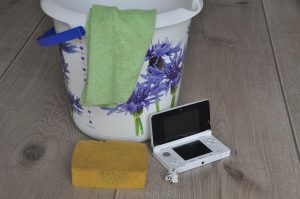 My parents were born and raised in Surinam. They moved to the Netherlands in the 70’s and raised their children there. Though not completely oblivious to Dutch culture, the way my parents raised me was greatly influenced by the motherland. That includes the way chores were done.
My parents were born and raised in Surinam. They moved to the Netherlands in the 70’s and raised their children there. Though not completely oblivious to Dutch culture, the way my parents raised me was greatly influenced by the motherland. That includes the way chores were done.
In Surinam, and I’m guessing in many non-Western (“Second World”) cultures, chores are simply a part of life. They are part of a daily routine in which all family members share the responsibility of running a household. As a kid, you go to school, do your chores and play in the time that is left. Dinners are prepared together, cleaning is a joint effort and in some cases, children even help parents with their jobs. Except for that last part, this is basically the way I was raised.
My Dutch husband has been raised completely differently. Chores were the responsibility of his parents. They took care of everything and as he got older, chores were gradually given to him as a way to teach him responsibility. I must add that not all Dutch kids are raised exactly the same and that there are many varieties, but the difference between Dutch and Surinam upbringing is apparent.
One of the thoughts behind Dutch upbringing: “Let children be children, let them play. Let them enjoy childhood without too many responsibilities. The time for responsibilities will come soon enough.”
Personally this thought appeals to me yet also conflicts me. I fear that my children will become entitled, spoiled and unable to deal with responsibilities if I simply let them play.
One of the thoughts behind Surinam upbringing: “Chores are normal and necessary and help kids to become responsible independent adults. Every member of the family has to do their share, family comes before individual needs.”
Having to raise children now myself, I need to find a balance between these very different approaches. And it is not easy to find a middle ground. My husband tends to have a “Here, let me do it for you” attitude. And I have a more “I am not your maid, I will teach you to do it yourself” attitude.
I have a sense of contentment and pride when I teach my kids to do their chores independently and without complaint. But I also understand how nice it is for a child to be shielded from too much responsibility and to simply be taken care of. I want to let my kids enjoy their free time in between school, homework and sports, but I also want them to help around the house and feel like they share some of the responsibility of our household.
And so I go back and forth. Some of my Dutch friends drop their jaws or raise their eyebrows when they learn that my kids clean, vacuum, mop their rooms and scrub the toilets every weekend. And my mother will feed my guilt by asking me why I don’t let the kids help around the house more.
My background does have one distinctive benefit. When my children moan about having to do chores, I tell them about my childhood and they stop complaining immediately.
What are your thoughts about chores? Does the way you raise your kids look more like the Dutch way or the Surinam way?
This is an original post to World Moms Blog by Mirjam of The Netherlands. Photo credit to the author.
Mirjam was born in warm, sunny Surinam, but raised in the cold, rainy Netherlands.
She´s the mom of three rambunctious beauties and has been married for over two decades to the love of her life.
Every day she´s challenged by combining the best and worst of two cultures at home.
She used to be an elementary school teacher but is now a stay at home Mom. In her free time she loves to pick up her photo camera.
Mirjam has had a life long battle with depression and is not afraid to talk about it.
She enjoys being a blogger, an amateur photographer, and loves being creative in many ways.
But most of all she loves live and laughter, even though sometimes she is the joke herself.
You can find Mirjam (sporadically) at her blog Apples and Roses where she blogs about her battle with depression and finding beauty in the simplest of things. You can also find Mirjam on Twitter and Instagram.
More Posts - Website
Follow Me:


























